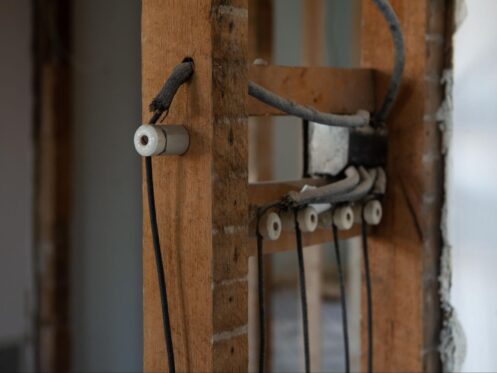There’s something undeniably cozy about older homes. But beneath those hardwood floors and crown moldings may lurk some serious electrical hazards that modern homes are less likely to face. If your home was built before the days of smart gadgets, electric vehicles, or central air conditioning, it might be hiding outdated components that can’t keep up with today’s technology.
From fuse boxes that should’ve been retired decades ago to missing ground connections that put your safety at risk, these issues are not only inconvenient but also dangerous. Do you have any of these electric hazards in your older home?
Identifying Electrical Hazards in Older Homes
Let’s break down the most common problems older homes face. Each one deserves attention, not just because of the inconvenience but because of the risk they pose to your health, safety, and even your home insurance.
1. Knob-and-Tube Wiring
This ancient electrical wiring system was popular in homes built before the 1940s. It’s not grounded and was never intended to handle today’s electrical load. The insulation around the wires tends to degrade over time, and since they’re often found in the attic, basement, or crawl space, they’re also more prone to wear, heat, and corrosion.
2. Aluminum Wiring
Used during the 1960s and 70s as a cheaper alternative to copper, aluminum wiring is notorious for corrosion, overheating, and increasing the risk of short circuits and fires. If your outlets feel warm or switches spark, aluminum may be to blame.
3. Outdated Fuse Panels
Before the circuit breaker panel became the standard, homes relied on fuses to prevent overloading. But, these old systems lack the protective features of modern panels and often allow circuits to be dangerously overloaded when using power strips or big appliances.
4. Missing GFCIs and AFCIs
Modern homes are required by the electrical code to have GFCI (Ground Fault Circuit Interrupter) and AFCI (Arc Fault Circuit Interrupter) protection in specific areas like the bathroom, kitchen, garage, and outdoor spaces. If your older home doesn’t have these, you’re vulnerable to fire and electrocution hazards.
5. Ungrounded Outlets
Those old two-prong outlets? They don’t provide a safe path to the ground, which means your plugged-in electronics, from your laptop to your refrigerator, are at risk during a lightning strike or power surge.
6. Lack of Smoke and Carbon Monoxide Detectors
A surprising number of older homes don’t have enough smoke detectors or carbon monoxide detectors — and some don’t have any at all. That’s a serious issue when dealing with aging furnaces, old wires, or sketchy appliances.
7. DIY or Unpermitted Electrical Work
Back in the day, DIY jobs were common, but that doesn’t mean they were done right. If you’ve had some “creative” home improvement done in the past, it’s time for a professional inspection to verify what’s up to code.
Outdated Wiring Systems: Risks and Solutions
Old electrical wiring can’t keep up with the demands of modern living. From dishwashers to charging stations and smart home automation, our homes consume far more electricity than they used to. When wires are too old or too small for the job, they get hot. And when they get hot, they can spark fires, especially in places like the attic, crawl space, or walls full of dry wood.
The fix? Replace aging wiring with modern materials like copper, install a new distribution board, and upgrade outlets and switches to meet the National Electrical Code. Yes, it’s an investment, but it’s far cheaper than the cost of an electrical fire.
The Dangers of Overloaded Circuits
Think of your circuit breaker as the first line of defense against electrical faults. Plug in too many electronics, turn on the air conditioning, run your dishwasher, and suddenly — snap — you’ve tripped a breaker. That’s not a glitch. It’s a warning.
Older homes weren’t built for our modern electrical demands. When you force more current through a circuit than it’s designed to handle, it heats up and can cause a fire. Worse, if you’re using an outdated fuse box or have an incorrectly sized wire, you might not get any warning at all. The result? Melted wires, smoke, and danger in the walls.
Importance of Proper Grounding in Electrical Systems
A ground connection gives electricity a safe exit path in case something goes wrong. Without it, excess electricity from a lightning strike, short circuit, or power surge can fry your appliances or, worse, zap you.
Many older homes weren’t built with proper grounding in mind. If your outlets aren’t grounded, your electronics, HVAC systems, and even your lighting could be at risk. Updating your grounding setup adds a crucial layer of fire safety and protects your devices from damage.
Lack of GFCI Outlets: A Hidden Hazard
Let’s talk about a true unsung hero of modern electrical safety: the GFCI outlet. That little button-equipped outlet may not look like much, but it’s a life-saver. Literally.
Ground Fault Circuit Interrupter (GFCI) outlets monitor the flow of electricity and cut the power instantly if they detect even a tiny imbalance. Why does that matter? Because those imbalances often happen when water gets involved.
Think kitchen, bathroom, basement, laundry room, garage — anywhere water and wires might cross paths. In homes built before the 1970s or 80s, GFCI outlets might be missing altogether, leaving you vulnerable to electrical shock or worse. That’s not only dangerous, but it’s also against modern building codes. Replacing old outlets with GFCIs is a fast fix with a major safety payoff.
Upgrading Electrical Systems in Historic Homes
Restoring a historic home? Great! While the aesthetics of an old house are timeless, the electrical infrastructure most definitely is not. Trying to run today’s energy-hungry appliances, electric vehicles, and smart home automation systems on circuits designed for a couple of lamps and a radio just doesn’t cut it.
The key is to upgrade thoughtfully. Work with a licensed electrician who understands both modern electrical code and the unique challenges of older construction. You might need to replace the distribution board, install dedicated circuits for large appliances, or even rewire entire sections of the home. Yes, it’s an investment in home improvement, but it protects your energy systems, your property, and, most importantly, the people inside.
Scheduling a Comprehensive Electrical Safety Inspection with Hope Plumbing, Heating and Cooling
So, how do you catch these hidden hazards before they become headlines? One word: inspection. A thorough home electrical safety inspection doesn’t just check for visible damage. It goes behind the scenes to assess your electrical network, wires, voltage levels, grounding systems, panel load, and more.
At Hope Plumbing, Heating and Cooling, our licensed electricians in Indianapolis know exactly what to look for. We inspect your attic, basement, crawl space, and behind-the-wall distribution board setups for corrosion, outdated parts, overloaded circuits, and anything that could pose a fire or shock hazard. We even test your smoke detectors, carbon monoxide detectors, and surge protectors to make sure your systems are working as hard as you are.
And if we spot something that needs upgrading? We’ll walk you through every option, from simple switch replacements to full-scale rewiring, without pressure or surprises. Our goal is to make your home safer, smarter, and more energy-efficient than ever. Contact us today to schedule an electrical safety inspection in Indianapolis.


